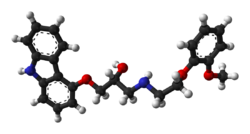Chemistry:Carvedilol
 | |
 | |
| Clinical data | |
|---|---|
| Trade names | Coreg, others |
| Other names | BM-14190 |
| AHFS/Drugs.com | Monograph |
| MedlinePlus | a697042 |
| License data |
|
| Routes of administration | By mouth |
| ATC code | |
| Legal status | |
| Legal status |
|
| Pharmacokinetic data | |
| Bioavailability | 25–35% |
| Protein binding | 98% |
| Metabolism | Liver (CYP2D6, CYP2C9) |
| Elimination half-life | 7–10 hours |
| Excretion | Urine (16%), feces (60%) |
| Identifiers | |
| |
| CAS Number | |
| PubChem CID | |
| IUPHAR/BPS | |
| DrugBank | |
| ChemSpider | |
| UNII | |
| KEGG | |
| ChEBI | |
| ChEMBL | |
| PDB ligand | |
| Chemical and physical data | |
| Formula | C24H26N2O4 |
| Molar mass | 406.482 g·mol−1 |
| 3D model (JSmol) | |
| Chirality | Racemic mixture |
| |
| |
| (verify) | |
Carvedilol, sold under the brand name Coreg among others, is a medication used to treat high blood pressure, congestive heart failure (CHF), and left ventricular dysfunction in people who are otherwise stable.[1] For high blood pressure, it is generally a second-line treatment.[1] It is taken by mouth.[1]
Common side effects include dizziness, tiredness, joint pain, low blood pressure, nausea, and shortness of breath.[1] Severe side effects may include bronchospasm.[1] Safety during pregnancy or breastfeeding is unclear.[2] Use is not recommended in those with liver problems.[3] Carvedilol is a nonselective beta blocker and alpha-1 blocker.[1] How it improves outcomes is not entirely clear but may involve dilation of blood vessels.[1]
Carvedilol was patented in 1978 and approved for medical use in the United States in 1995.[1][4] It is on the World Health Organization's List of Essential Medicines.[5] It is available as a generic medication.[1] In 2021, it was the 26th most commonly prescribed medication in the United States, with more than 21 million prescriptions.[6][7]
Medical uses
Carvedilol is indicated in the management of congestive heart failure (CHF), commonly as an adjunct to angiotensin-converting-enzyme inhibitor (ACE inhibitors) and diuretics. It has been clinically shown to reduce mortality and hospitalizations in people with CHF.[8] The mechanism behind its positive effect when used long-term in clinically stable CHF patients is not fully understood, but is thought to contribute to remodeling of the heart, improving upon its structure and function.[9][10]
Carvedilol reduces the risk of death, hospitalizations, and recurring heart attacks for patients with reduced heart function following a heart attack.[11][12] Carvedilol has also been proven to reduce death and hospitalization in patients with severe heart failure.[13]
In practice, carvedilol has been used in the treatment of uncomplicated hypertension, yet studies suggest it has relatively ineffective blood pressure-lowering effects when compared with other blood pressure-lowering therapies or other beta blockers.[14]
Carvedilol has also shown efficacy in the prevention of bleeding from esophageal varices in patients with cirrhosis.[15]
Available forms
Carvedilol is available in the following forms:
Contraindications
Carvedilol should not be used in patients with bronchial asthma or bronchospastic conditions due to increased risk of bronchoconstriction.[18][19] It should not be used in people with second- or third-degree atrioventricular block, sick sinus syndrome, severe bradycardia (unless a permanent pacemaker is in place), or a decompensated heart condition. People with severe hepatic impairment should use carvedilol with caution.[20][21][22]
Side effects
The most common side effects (>10% incidence) of carvedilol include:[16]
- Dizziness
- Fatigue
- Low blood pressure
- Diarrhea
- Weakness
- Slowed heart rate
- Weight gain
- Erectile dysfunction
Carvedilol is not recommended for people with uncontrolled bronchospastic disease (e.g. current asthma symptoms) as it can block receptors that assist in opening the airways.[16]
Carvedilol may mask symptoms of low blood sugar,[16] resulting in hypoglycemia unawareness. This is termed beta blocker induced hypoglycemia unawareness.
Pharmacology
Pharmacodynamics
| Site | Ki (nM) | Action |
|---|---|---|
| 5-HT1A | 3.4 | Antagonist |
| 5-HT2 | 207 | Antagonist |
| D2 | 213 | Antagonist |
| α1 | 3.4 | Antagonist |
| α2 | 2,168 | Antagonist |
| β1 | 0.24–0.43 | Antagonist |
| β2 | 0.19–0.25 | Antagonist |
| M2 | ? | Antagonist[23] |
Carvedilol is both a non-selective β-adrenergic receptor antagonist (β1, β2) and an α-adrenergic receptor antagonist (α1). The S(–) enantiomer accounts for the beta-blocking activity whereas the S(–) and R(+) enantiomers have alpha-blocking activity.[16] The affinity (Ki) of carvedilol for the β-adrenergic receptors is 0.32 nM for the human β1-adrenergic receptor and 0.13 to 0.40 nM for the β2-adrenergic receptor.[24]
Using rat proteins, carvedilol has shown affinity for a variety of targets including the β1-adrenergic receptor (Ki = 0.24–0.43 nM), β2-adrenergic receptor (Ki = 0.19–0.25 nM), α1-adrenergic receptor (Ki = 3.4 nM), α2-adrenergic receptor (Ki = 2,168 nM), 5-HT1A receptor (Ki = 3.4 nM), 5-HT2 receptor (Ki = 207 nM), H1 receptor (Ki = 3,034 nM), D2 receptor (Ki = 213 nM), μ-opioid receptor (Ki = 2,700 nM), veratridine site of voltage-gated sodium channels (IC50 = 1,260 nM), serotonin transporter (Ki = 528 nM), norepinephrine transporter (Ki = 2,406 nM), and dopamine transporter (Ki = 627 nM).[25] It is an antagonist of the human 5-HT2A receptors with moderate affinity (Ki = 547 nM), although it is unclear if this is significant for its pharmacological actions given its much stronger activity at adrenergic receptors.[26]
Carvedilol reversibly binds to β-adrenergic receptors on cardiac myocytes. Inhibition of these receptors prevents a response to the sympathetic nervous system, leading to decreased heart rate and contractility. This action is beneficial in heart failure patients where the sympathetic nervous system is activated as a compensatory mechanism.[27] Carvedilol blockade of α1-adrenergic receptors causes vasodilation of blood vessels. This inhibition leads to decreased peripheral vascular resistance and an antihypertensive effect. There is no reflex tachycardia response due to carvedilol blockade of β1-adrenergic receptors on the heart.[28]
Pharmacokinetics
Carvedilol is about 25% to 35% bioavailable following oral administration due to extensive first-pass metabolism. Absorption is slowed when administered with food, however, it does not show a significant difference in bioavailability. Taking carvedilol with food decreases the risk of orthostatic hypotension.[16]
The majority of carvedilol is bound to plasma proteins (98%), mainly to albumin. Carvedilol is a basic, hydrophobic compound with a steady-state volume of distribution of 115 L. Plasma clearance ranges from 500 to 700 mL/min.[16] Carvedilol is lipophilic and easily crosses the blood–brain barrier in animals, and hence is not thought to be peripherally selective.[29][30]
The compound is metabolized by liver enzymes, CYP2D6 and CYP2C9 via aromatic ring oxidation and glucuronidation, then further conjugated by glucuronidation and sulfation. The three active metabolites exhibit only one-tenth of the vasodilating effect of the parent compound. However, the 4'-hydroxyphenyl metabolite is about 13-fold more potent in β-blockade than the parent.[16]
The mean elimination half-life of carvedilol following oral administration ranges from 7 to 10 hours. The pharmaceutical product is a mix of two enantiomorphs, R(+)-carvedilol and S(–)-carvedilol, with differing metabolic properties. R(+)-Carvedilol undergoes preferential selection for metabolism, which results in a fractional half-life of about 5 to 9 hours, compared with 7 to 11 hours for the S(-)-carvedilol fraction.[16]
References
- ↑ 1.0 1.1 1.2 1.3 1.4 1.5 1.6 1.7 1.8 "Carvedilol Monograph for Professionals". AHFS. https://www.drugs.com/monograph/carvedilol.html.
- ↑ "Carvedilol Use During Pregnancy". https://www.drugs.com/pregnancy/carvedilol.html.
- ↑ British national formulary : BNF 76 (76 ed.). Pharmaceutical Press. 2018. pp. 147. ISBN 9780857113382.
- ↑ Analogue-based Drug Discovery. John Wiley & Sons. 2006. p. 463. ISBN 9783527607495. https://books.google.com/books?id=FjKfqkaKkAAC&pg=PA463.
- ↑ World Health Organization model list of essential medicines: 22nd list (2021). Geneva: World Health Organization. 2021. WHO/MHP/HPS/EML/2021.02.
- ↑ "The Top 300 of 2021". https://clincalc.com/DrugStats/Top300Drugs.aspx.
- ↑ "Carvedilol - Drug Usage Statistics". https://clincalc.com/DrugStats/Drugs/Carvedilol.
- ↑ "2013 AHA Guidelines for the Management of Heart Failure". Circulation 128 (16): e240-327. 15 October 2013. doi:10.1161/CIR.0b013e31829e8776. PMID 23741058. http://circ.ahajournals.org/content/early/2013/06/03/CIR.0b013e31829e8776.full.pdf.
- ↑ Basic and Clinical Pharmacology (11th ed.). New York: McGraw-Hill Medical Publishing Division. 2009. pp. 189. ISBN 9780071604055.
- ↑ "Reverse Cardiac Remodeling: A Marker of Better Prognosis in Heart Failure". Arquivos Brasileiros de Cardiologia 104 (6): 502–6. June 2015. doi:10.5935/abc.20150025. PMID 26131706.
- ↑ "Effect of carvedilol on outcome after myocardial infarction in patients with left-ventricular dysfunction: the CAPRICORN randomised trial". Lancet 357 (9266): 1385–1390. May 2001. doi:10.1016/s0140-6736(00)04560-8. PMID 11356434.
- ↑ "Meta-Analysis of Relation Between Oral β-Blocker Therapy and Outcomes in Patients With Acute Myocardial Infarction Who Underwent Percutaneous Coronary Intervention". The American Journal of Cardiology 115 (11): 1529–1538. June 2015. doi:10.1016/j.amjcard.2015.02.057. PMID 25862157.
- ↑ "Beta-blockers for heart failure with reduced, mid-range, and preserved ejection fraction: an individual patient-level analysis of double-blind randomized trials". European Heart Journal 39 (1): 26–35. January 2018. doi:10.1093/eurheartj/ehx564. PMID 29040525.
- ↑ "Blood pressure lowering efficacy of dual alpha and beta blockers for primary hypertension". The Cochrane Database of Systematic Reviews 2015 (8): CD007449. August 2015. doi:10.1002/14651858.cd007449.pub2. PMID 26306578.
- ↑ "Carvedilol for primary prophylaxis of variceal bleeding in cirrhotic patients with haemodynamic non-response to propranolol". Gut 62 (11): 1634–1641. November 2013. doi:10.1136/gutjnl-2012-304038. PMID 23250049.
- ↑ 16.0 16.1 16.2 16.3 16.4 16.5 16.6 16.7 16.8 "Coreg - Food and Drug Administration". http://www.accessdata.fda.gov/drugsatfda_docs/label/2009/020297s029lbl.pdf.
- ↑ "Drug Approval Package". http://www.accessdata.fda.gov/drugsatfda_docs/nda/2006/022012s000TOC.cfm.
- ↑ "Respiratory effect of beta-blockers in people with asthma and cardiovascular disease: population-based nested case control study". BMC Medicine 15 (1): 18. January 2017. doi:10.1186/s12916-017-0781-0. PMID 28126029.
- ↑ "Tolerability of carvedilol in patients with heart failure and concomitant chronic obstructive pulmonary disease or asthma". The Journal of Heart and Lung Transplantation 21 (12): 1290–5. December 2002. doi:10.1016/s1053-2498(02)00459-x. PMID 12490274.
- ↑ "Carvedilol use is associated with improved survival in patients with liver cirrhosis and ascites". Journal of Hepatology 67 (1): 40–46. July 2017. doi:10.1016/j.jhep.2017.02.005. PMID 28213164. https://www.pure.ed.ac.uk/ws/files/33500796/Carvedilol_manuscript_RS_KALdocx.pdf.
- ↑ "Carvedilol versus traditional, non-selective beta-blockers for adults with cirrhosis and gastroesophageal varices". The Cochrane Database of Systematic Reviews 2018 (10): CD011510. October 2018. doi:10.1002/14651858.CD011510.pub2. PMID 30372514.
- ↑ "Randomized, controlled trial of carvedilol versus nadolol plus isosorbide mononitrate for the prevention of variceal rebleeding". Journal of Gastroenterology and Hepatology 27 (11): 1681–7. November 2012. doi:10.1111/j.1440-1746.2012.07244.x. PMID 22849337.
- ↑ Xu, Xiao-Li; Zang, Wei-Jin; Lu, Jun; Kang, Xin-Qin; Li, Ming; Yu, Xiao-Jiang (2006-12-30). "Effects of carvedilol on M2 receptors and cholinesterase-positive nerves in adriamycin-induced rat failing heart". Autonomic Neuroscience: Basic & Clinical 130 (1-2): 6–16. doi:10.1016/j.autneu.2006.04.005. ISSN 1566-0702. PMID 16798104. https://pubmed.ncbi.nlm.nih.gov/16798104/.
- ↑ "Carvedilol | Ligand page | IUPHAR/BPS Guide to PHARMACOLOGY". https://www.guidetopharmacology.org/GRAC/LigandDisplayForward?tab=biology&ligandId=551.
- ↑ "The receptor binding profile of the new antihypertensive agent nebivolol and its stereoisomers compared with various beta-adrenergic blockers". Mol Pharmacol 34 (6): 843–51. December 1988. PMID 2462161. https://molpharm.aspetjournals.org/content/34/6/843.long.
- ↑ "The adrenergic receptor antagonist carvedilol interacts with serotonin 2A receptors both in vitro and in vivo". Pharmacology, Biochemistry, and Behavior 181: 37–45. June 2019. doi:10.1016/j.pbb.2019.04.003. PMID 30998954.
- ↑ "Beta blockers for congestive heart failure". Acta Medica Indonesiana 39 (1): 44–8. 2007. PMID 17297209. http://www.inaactamedica.org/archives/2007/17297209.pdf. Retrieved 12 November 2015.
- ↑ "The pharmacology of carvedilol". European Journal of Clinical Pharmacology 38 (Suppl 2): S82–S88. 1990. doi:10.1007/BF01409471. PMID 1974511.
- ↑ "Carvedilol as a potential novel agent for the treatment of Alzheimer's disease". Neurobiol Aging 32 (12): 2321.e1–12. December 2011. doi:10.1016/j.neurobiolaging.2010.05.004. PMID 20579773.
- ↑ "New positron emission tomography tracer [(11)Ccarvedilol reveals P-glycoprotein modulation kinetics"]. Br J Pharmacol 145 (8): 1045–51. August 2005. doi:10.1038/sj.bjp.0706283. PMID 15951832.
Further reading
- "Clinical updates on carvedilol: a first choice beta-blocker in the treatment of cardiovascular diseases". Expert Opinion on Drug Metabolism & Toxicology 6 (2): 237–50. February 2010. doi:10.1517/17425250903540220. PMID 20073998.
- "Carvedilol Therapy and CYP2D6 Genotype". Medical Genetics Summaries. National Center for Biotechnology Information (NCBI). 2018. Bookshelf ID: NBK518573. https://www.ncbi.nlm.nih.gov/books/NBK518573/.
External links
 |

